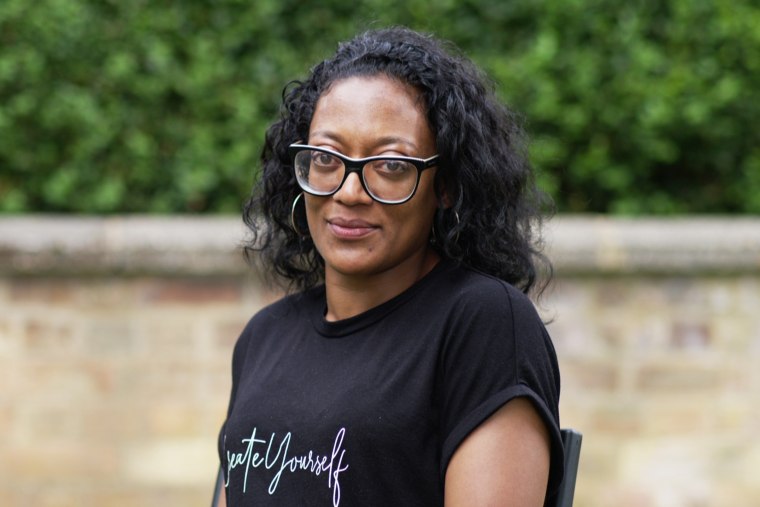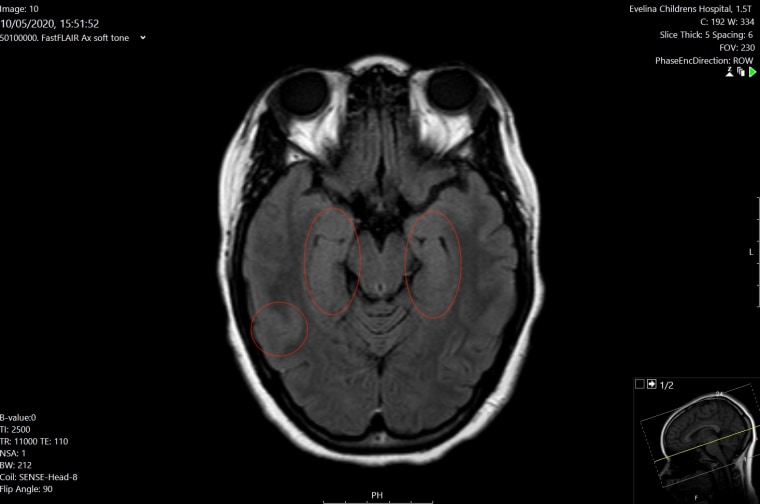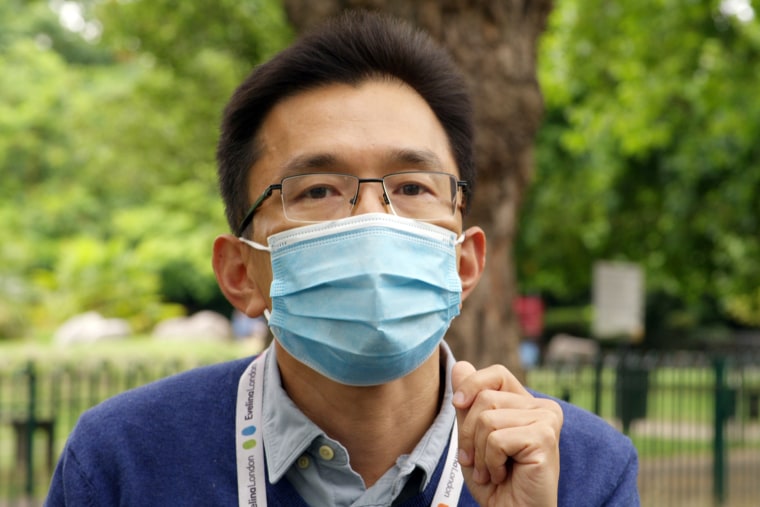LONDON — Nia Haughton, 15, occasionally struggles to find the right words, and her memory can be patchy, but as she describes her lengthy treatment in a London hospital as she sits on a low wall beside her home, her account still has the power to shock.

In early April, the British teen had been battling a cough and a high temperature for about 10 days, but when her condition significantly deteriorated her mother, Justina Ward, called for help.
After the emergency dispatcher heard Nia having difficulty breathing, an ambulance arrived within minutes. The first emergency room to admit her swiftly recognized that her illness was both acute and complex, and transferred her to one of central London’s top children’s hospitals. Soon after her arrival there with several recognizable COVID-19 symptoms, she was sedated and placed on a ventilator inside an intensive care unit, where she remained for two weeks.
Full coverage of the coronavirus outbreak
For days, her lungs labored to stave off collapse until the medical staff tried “proning” her for 16 hours a day. During proning, Nia was turned to lie on her front at a slight incline, but kept on ventilation with the help of an anesthesiologist. This approach allows oxygen to be blasted to the back of a patient’s lungs, and has been beneficial for many COVID-19 sufferers.
I don't know which was scarier, her being on the ventilator not being able to breathe, or the fact that she came out of it with a completely different personality.
Eventually, Nia turned a corner and was able to breathe again unaided. But after several days in recovery, her condition worsened once again. This time, it was her brain rather than her lungs that was affected. Awake night after night, she began hallucinating, seeing and hearing people in the hospital who were not really there.
“I couldn't tell what was real,” she said. “It was really scary. I could hear voices. It was very traumatic.”
After repeated, violent seizures that left her exhausted and sleeping for long periods, she was taken back into the ICU.

Watching the illness attack her daughter’s lungs and then her mental capacity was terrifying, Ward told NBC News, particularly since Nia's doctors were struggling to understand what was happening inside her nervous system and brain.
“I don't know which was scarier, her being on the ventilator not being able to breathe, or the fact that she came out of it with a completely different personality,” Ward, 42, said.
During this period, Nia’s voice and behavior appeared to regress to a younger version of herself. Pediatric neurologist Dr. Ming Lim of the Evelina London Children’s Hospital diagnosed her with encephalitis, an inflammation of the brain.
Lim, a soft-spoken but animated clinician with a long professional interest in childhood inflammatory disorders, said Nia’s diagnostic and antibody tests had both come back negative, but he had seen other patients with the same "COVID picture” of symptoms who had tested positive.

He said the unreliable nature of testing on many early patients, and the specificity and chronology of her symptoms, gave his team no reason to diagnose her with anything other than COVID-19.
He considered Nia’s neurological symptoms as a late-onset, secondary inflammatory illness associated with COVID-19.
“I think that COVID has taught us that every time we feel complacent, that we know the spectrum, a new spectrum sort of evolves,” Lim said.
He and his Evelina colleagues have successfully treated a handful of COVID-linked cases, but he remains focused on the future neurological implications for children.
“We worry that the long-term effect would be in essentially brain growth,” he said, a particular concern among children and young adults whose brains are still developing.

A series of four similar cases were detailed in a recent study published by JAMA, spearheaded by doctors at the Great Ormond Street Hospital, London’s other leading pediatric facility.
The children were part of a larger cohort of 27 young patients who had suffered from the recently recognized multisystem inflammatory syndrome in children, or MIS-C. They developed new-onset neurological symptoms, in the absence of other respiratory symptoms.
The study’s lead author Dr. Omar Abdel-Mannan, a pediatric neurology specialist at Great Ormond Street, said that children, in general, had “rarely been affected and been so sick.” And in these particular cases, the children affected had actually made “a pretty remarkable recovery.”
But he and several neurologists in the United Kingdom and the United States who spoke to NBC News said the vast scale of this pandemic — with confirmed cases in the U.S. topping 4 million — could translate into thousands of patients with neurological complications associated with COVID-19, with some of those potentially focused on the children who suffered the multisystem inflammatory syndrome.
“The virus has surprised us in many, many ways,” Abdel-Mannan said. “It does need really good quality longitudinal assessments and studies that will include looking at the cognition of these children, looking at their longer term psychological and psychiatric health.”
While there is evidence of higher rates of coronavirus infection among Black and Hispanic communities in the U.S., doctors say there isn’t yet enough data to confirm the relationship between race and the neurological side effects of COVID-19 in children.
'A sort of secondary pandemic'
The data available for adults is currently much clearer, experts said. Two recent British studies, one that looked at the neurological impact of COVID-19 on 43 patients ranging between the ages of 16 and 85, and another published in the Lancet examining 153 patients, ages 24 to 93, found that in those cases symptoms were varied but severe.
“They can have seizures, fever, they can have hallucinations that could be very disturbing for them or their family members, psychotic symptoms,” said Dr. Mike Zandi, a lead author of one study, co-author of the other and a consultant neurologist at Britain’s National Hospital for Neurology and Neurosurgery. “It can be very hard to distinguish what is psychiatric disease from medical disease.”
Research into the neurological effects of COVID-19 is still in its early stages, he said, but the adult patients included in the studies were infected by the coronavirus first, then exhibited a similar pattern of inflammation, allowing for “no other reasonable explanation.”
Download the NBC News app for full coverage of the coronavirus outbreak
Other neurologists in the U.S. share this elevated level of concern about the long-term implications and the multiplying impact of the pandemic on neurological health.
“When you have so many millions of people who are suffering from acute infection, I think it's only going to be a matter of time before we see more and more of these cases,” said Dr. Arun Venkatesan, a neurologist specializing in infectious diseases, who directs the John Hopkins Encephalitis Center. “We've certainly seen some, and I fear that we are just at the beginning.”
His Johns Hopkins colleague Dr. Robert Stevens, a critical care neurologist, predicted “a sort of secondary pandemic of people” who might experience problems further down the road.
“A fair number of people who get this disease wind up with some neurological manifestations, and these range from very mild to severe life-threatening conditions,” he said. “People who survive will recover from the respiratory failure, they'll recover from the kidney disease, but the imprint on the brain is likely to be much more long-lasting.”
He outlined several possible mechanisms by which the virus could be causing damage inside the brain, but said more data and research would be required to determine the causation more precisely.
That uncertainty is particularly pronounced among young patients, said Dr. Jennifer McGuire, a pediatric neurologist at the Children’s Hospital of Philadelphia, who has also noticed a recent uptick in patients with neurological symptoms.
“I would say headache and fatigue and a little bit of confusion are pretty common,” she said.
“It's not totally clear yet as to if those things are happening just because these kids are so systematically sick with SARS COVID-2,” she said, or whether it is the consequence of either “the post-infectious multisystem inflammatory syndrome,” or if these cases are “directly attributable to the neurological involvement of the virus.”
A large-scale study organized by the international Neurocritical Care Society, involving 96 treatment centers in 25 countries, is now underway. The goal is to identify and improve possible treatments relating to the brain and COVID-19. The doctors involved in treating patients like Nia — who weeks later suffers from flashbacks and significant memory problems — say they want to develop more precise and personalized approaches to the expanding neurological impact of this virus.
